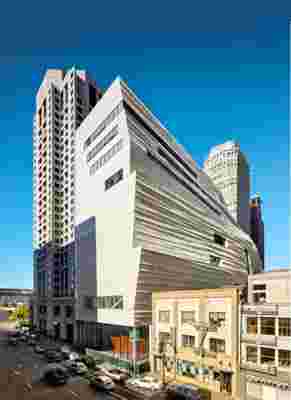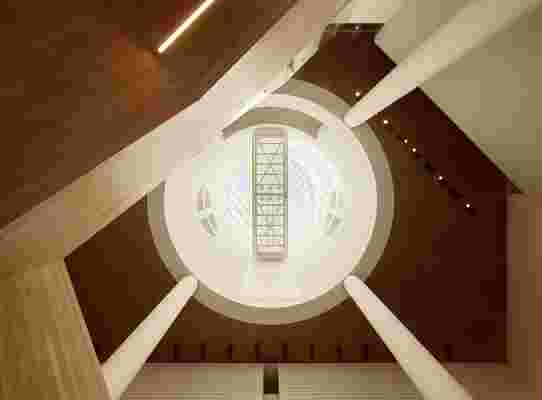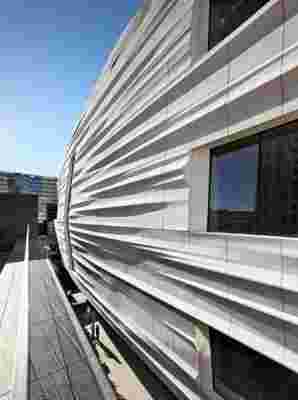Nearly three years ago the San Francisco Museum of Modern Art (SFMOMA) shut the doors to its longtime home, a brooding Cyclops of a building—built by architect Mario Botta in 1995—with graphic brickwork and a striking central rotunda. The edifice has since lain dormant, closed to the public while work moved forward on a $305 million overhaul by the international architecture-and-design firm Snøhetta. Now renovated and with a new addition, the museum will officially welcome crowds back on May 14. What visitors will find is something dramatically different: an institution with almost three times more exhibition space and a renewed focus on engaging the city that surrounds it.
A ten-story sliver clad in undulating panels of fiberglass-reinforced polymer, the 235,000-square-foot extension rises in one enormous thrust behind the Botta building, on a piece of land formerly occupied by a parking lot, an office building, and a firehouse. The new wing’s façade, embedded with particles of local sand that subtly sparkle like hazy sunshine, is meant to evoke both the rippling waters of the San Francisco Bay and the city’s famous fog. “You’re always aware of the light hitting the building,” says Snøhetta cofounder Craig Dykers. “The shadows and bright spots are constantly shifting.” Context was key for the museum’s director, Neal Benezra. “The design incorporates so many references to the city,” he says. “Snøhetta crafted a building that is uniquely San Franciscan.”

A view of the new wing from Howard Street.
As with previous Snøhetta projects—in particular the 2008 Oslo opera house, with its sloping network of plazas—the new SFMOMA seeks to integrate a revered cultural institution into the cityscape. “The goal was to make the museum more accessible,” says Dykers, explaining that it now boasts 170,000 square feet of exhibition space, a quarter of which has free admission. These open galleries begin in the complex’s two main entrances. From Howard Street, visitors enter the new wing via a glass-walled room that was built to house a 235-ton sculpture by Richard Serra. Those coming in through the old Third Street building, on the other hand, will still find Botta’s soaring atrium, but the space’s hulking statement staircase has been replaced by a suspended set of steps that exposes the oculus overhead, making way for a giant Alexander Calder mobile. Both entries lead to a shared second-floor lobby, which will be home to a vast Sol LeWitt wall drawing. “People can move around freely and feel like the museum is theirs,” Dykers says of the layout, which allows anyone to experience major masterpieces without ever having to purchase a ticket.

A view of the oculus in the museum’s soaring atrium.
Admission, however, is required to continue into the lobby’s adjacent galleries (featuring highlights from the permanent collection) and further upstairs, where the new wing contains an additional five stories of exhibition space. The inaugural presentation of art will showcase 260 pieces from a trove of 1,100 works promised to the museum from the collection of Doris and Donald Fisher (the couple who founded the Gap), among them creations by such greats as Chuck Close, Joan Mitchell, Cy Twombly, and Andy Warhol. On the third floor, meanwhile, is the new 15,000-square-foot Pritzker Center for Photography, which ranks as the country’s largest art space dedicated to the medium. Elsewhere there’s a sweep of 11 more Calder sculpture—some indoor, some outdoor—an octagonal gallery displaying seven Agnes Martin paintings, and a terrace hemmed in by the largest green wall in the U.S.
These moments crop up seemingly at random in the structure’s irregular floor plan. But this, Dykers explains, is by design. “We created targets,” says the architect, referring to points of interest that break up the progression, drawing visitors onward while providing occasions of respite. Consider it choreography. Describing the new wing and its relationship to the Botta building, Dykers says simply, “It’s an excellent dancing partner.” sfmomarg

